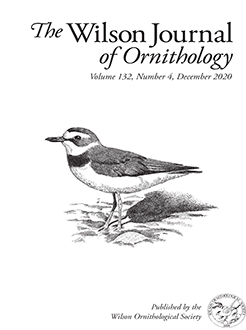Birds face many human-induced environmental challenges that we associate with population declines. Because of this, we need more ways to monitor populations before they become endangered. Several authors have proposed that fluctuating asymmetry, or nondirectional deviation from bilateral symmetry, could be used as an indicator of population declines. Fluctuating asymmetry is linked to developmental instability and stress associated with environmental challenges such as habitat loss in populations of birds and other animals. Two key premises of the argument for linking fluctuating asymmetry and population declines are that (1) fluctuating asymmetry changes over time, and (2) change over time results in overall population- or species-level differences in fluctuating asymmetry. I evaluated these premises by measuring tarsus and hallux lengths of museum specimens primarily from 1875–1950 in a pair of closely related species with different population statuses—the White-breasted Nuthatch (Sitta carolinensis) and the Brown-headed Nuthatch (S. pusilla). Since Brown-headed Nuthatch populations are decreasing whereas White-breasted Nuthatch populations are increasing, I predicted that Brown-headed Nuthatches would have increasing fluctuating asymmetry over time whereas White-breasted Nuthatches would have no change or decreasing fluctuating asymmetry over time, and this would result in Brown-headed Nuthatches having more overall fluctuating asymmetry in both morphological traits than White-breasted Nuthatches. The percent asymmetry of tarsi and halluces for Brown-headed Nuthatches were at least 1.5× higher than the corresponding values for White-breasted Nuthatches, which supported the second premise. However, since I also found that there was a great deal of interindividual variation and no change in fluctuating asymmetry over time in either species, it is still unclear whether fluctuating asymmetry could be used to help monitor populations for evidence of decline before they reach endangered status. Future studies should more broadly and deeply explore the associations between avian population declines and fluctuating asymmetry.
How to translate text using browser tools
14 September 2021
Brown-headed Nuthatches (Sitta pusilla) have more fluctuating asymmetry than White-breasted Nuthatches (S. carolinensis) but no change over 75 years
Emily A. Webb
ACCESS THE FULL ARTICLE
biomarker
conservation biology
morphological asymmetry
morphology
museum collections
passerine
southeast United States





